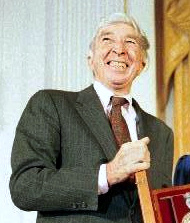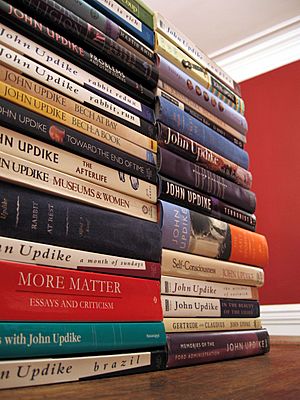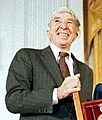John Updike facts for kids
Quick facts for kids
John Updike
|
|
|---|---|

Updike in 1989
|
|
| Born | John Hoyer Updike March 18, 1932 Reading, Pennsylvania, United States |
| Died | January 27, 2009 (aged 76) Danvers, Massachusetts, United States |
| Occupation | Novelist, short-story writer, poet, literary critic, artist |
| Genre | Literary realism |
| Signature | |
 |
|
John Hoyer Updike (March 18, 1932 – January 27, 2009) was a famous American writer. He wrote many novels, poems, and short stories. He also wrote about art and books.
Updike was one of only three writers to win the Pulitzer Prize for Fiction more than once. This is a very important award for writers. He published over twenty novels and many collections of short stories. He also wrote children's books.
Many of his stories and poems appeared in The New Yorker magazine, starting in 1954. His most famous works are the "Rabbit" novels. These books follow the life of a character named Harry "Rabbit" Angstrom as he grows up and gets older. Two of these "Rabbit" books, Rabbit Is Rich (1982) and Rabbit at Rest (1990), won the Pulitzer Prize.
John Updike is seen as one of the best American fiction writers of his time. Many people admired his writing style.
Contents
Early Life and Education
John Updike was born in Reading, Pennsylvania. He was the only child of Linda Grace and Wesley Russell Updike. He grew up in a small town nearby called Shillington. His family later moved to a village called Plowville.
His mother wanted to be a writer, and this inspired young John. He remembered seeing her at her desk with her typewriter and clean paper. He also remembered the brown envelopes where stories would be sent out and sometimes returned. These early years in Pennsylvania influenced many of his stories and novels.
Updike was a very good student. He graduated from Shillington High School in 1950. He was one of the top students in his class and the class president. He won a scholarship to Harvard College.
At Harvard, Updike became well-known for his writing. He wrote for The Harvard Lampoon, a humor magazine, and even became its president. He graduated in 1954 with a degree in English.
After Harvard, Updike went to art school in England at the Ruskin School of Drawing and Fine Art at the University of Oxford. He hoped to become a cartoonist. When he returned to the United States, he and his family moved to New York. There, he started writing regularly for The New Yorker magazine. This was the start of his professional writing career.
Writing Career and Famous Works
Updike worked full-time at The New Yorker for two years. He wrote columns, poems, and short stories for the magazine. Later, he and his family moved to Ipswich, Massachusetts.
In Ipswich, Updike wrote some of his most famous books. These include Rabbit, Run (1960) and The Centaur (1963). The Centaur won the National Book Award, another important literary prize.
Rabbit, Run introduced Harry "Rabbit" Angstrom. Rabbit was a former high school basketball star. He became Updike's most famous character. Updike wrote three more novels about Rabbit's life. Time magazine even listed Rabbit, Run as one of the 100 greatest novels of all time.
Updike's connection with The New Yorker helped his career grow. The magazine published many of his works throughout his life. His "Maple" short stories, collected in Too Far To Go (1979), showed parts of his first marriage. Some of these stories were even made into a TV movie.
Updike's short stories were gathered into several books over many years. In 2013, a special two-volume collection of 186 of his stories was published.
In 1971, he published Rabbit Redux, a sequel to Rabbit, Run. This book showed how the character Rabbit reacted to the big social changes happening in the 1960s.
In 1990, Updike published the last "Rabbit" novel, Rabbit at Rest. This book won both the Pulitzer Prize and the National Book Critics Circle Award. It is a long novel and one of Updike's most celebrated.
After the "Rabbit" series, Updike wrote many different kinds of novels. He explored various styles, like historical fiction in Memories of the Ford Administration (1992) and science fiction in Toward the End of Time (1997).
He also wrote a more traditional novel, In the Beauty of the Lilies (1996). This book told a story across several generations and explored themes of religion and movies in America. It is considered one of his most successful later novels.
In 2003, Updike published The Early Stories. This was a large collection of his short stories from the mid-1950s to the mid-1970s.
Near the end of his life, Updike was working on a novel about St. Paul and early Christianity. When he passed away, The New Yorker magazine called him "one of the greatest of all modern writers."
Personal Life and Passing
John Updike married Mary E. Pennington in 1953 while he was still a student. She was an art student. They went to Oxford, England, where their first child was born in 1955. They had three more children together. They divorced in 1974. Updike had seven grandsons.
In 1977, Updike married Martha Ruggles Bernhard. They lived together for over thirty years in Beverly Farms, Massachusetts. John Updike passed away from lung cancer on January 27, 2009. He was 76 years old.
In Popular Culture
- Updike appeared on the cover of Time magazine twice.
- In 2000, Updike played himself in an episode of The Simpsons called Insane Clown Poppy.
- The main character in the movie 8 Mile (2002), played by Eminem, is nicknamed "Rabbit." This character has some similarities to Updike's character, Rabbit Angstrom. The movie's soundtrack also has a song called "Rabbit Run."
- Pictures of Updike drawn by the artist David Levine appeared several times in The New York Review of Books.
Awards and Recognition
John Updike received many awards for his writing throughout his career. Some of these include:
- 1959 Guggenheim Fellow
- 1964 National Book Award for Fiction
- 1981 National Book Critics Circle Award for Fiction
- 1982 Pulitzer Prize for Fiction
- 1989 National Medal of Arts
- 1990 National Book Critics Circle Award for Fiction
- 1991 Pulitzer Prize for Fiction
- 1995 William Dean Howells Medal
- 1998 Medal for Distinguished Contribution to American Letters
- 2003 National Humanities Medal
- 2004 PEN/Faulkner Award for Fiction
- 2007 American Academy of Arts and Letters Gold Medal for Fiction
Images for kids
See also
 In Spanish: John Updike para niños
In Spanish: John Updike para niños





